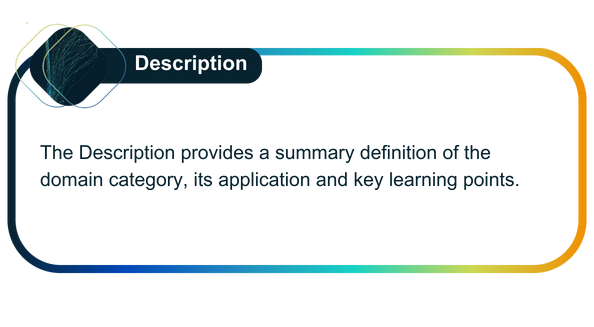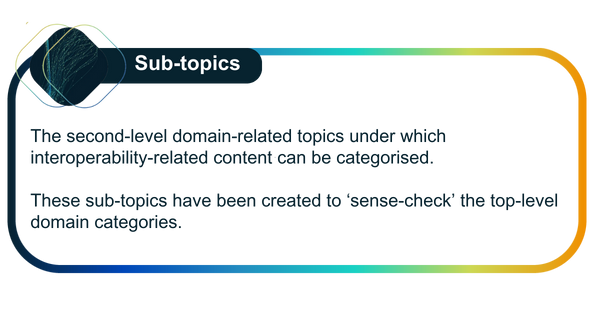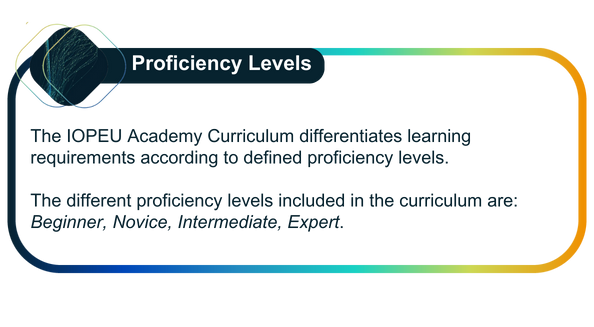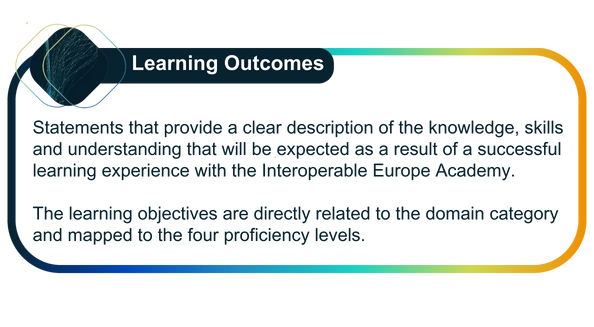Introduction
The Interoperable Europe Academy Curriculum equips public servants with advanced digital skills, focused on interoperability. This curriculum provides a structured programme of interoperability-related topics and sub-topics.
The Curriculum offers educational resources to support the implementation of Europe’s Digital Decade and the forthcoming Interoperable Europe Act.
01 - The Concept of Interoperability
|
The learners will develop an understanding about Interoperability, including the need for interoperability, the interoperability environment and the initiatives of the European Commission. They will also be able to provide the definition of interoperability and describe the main European Interoperability Framework concepts, as well as the main enablers and the main barriers for achieving interoperability. |
| 1. Introduction to interoperability 2. Openness and transparency / Open Government 3. User-centricity / User experience and citizen centric public services 4. Inclusion and accessibility / The web accessibility intitiative 5. Security and privacy /Cybersecurity policy and practices 6. Interoperable Europe Act (Introduction) a) Governance b) Interoperability assessment in support of digital-ready policymaking c) Interoperability solutions d) Interoperability support measures including training and innovation |
| Proficiency Level | Learning Outcomes |
|---|---|
| Beginner | 1. Understand the definition of interoperability. 2. Understand the main European Interoperability Framework (EIF) concepts and the main barriers for achieving interoperability. 3. Identify, locate, assess, reuse tools and participate in communities that accelerate the creation of interoperable public services. |
| Novice | 1. Can reference important Member State examples of Open Government. 2. Understand the nature and importance of communities of practice. 3. Understand the importance of user centricity, accessibility and inclusiveness. 4. Can reference key cyber-security policies and practices from Member States. |
| Intermediate | 1. Can describe the main components of the Interoperable Europe Act. 2. Able to navigate the Joinup portal and Interoperable Europe Portal. 3. Can summarise the definition of the Interoperability asessment, Interoperable Europe Solutions, the Interoperable Europe Portal and the Interoperable Europe Board. |
02 - The European Interoperability Framework
| The learner will be able to describe the role and the main components of the European Interoperability Framework. The learner will also develop an understanding of how the European Interoperability Framework, the National Interoperability Frameworks and the Domain Interoperability Frameworks interact, complement each other, and contribute to implementation of interoperability in Europe. This topic category also provides a stable background to the learner on how the European Interoperability Framework, Principles, Recommendation, Layers, and Governance Model can be used to facilitate and accelerate the public service delivery. |
| 1. Seamless Public services 2. The EIF layers 3. The 12 principles 4. The EIF public service model 5. The EIF recommendations 6. EIF Components 7. Integrated public service governance 8. European Interoperability Framework (EIF) with Smart Cities and Communities |
| Proficiency Level | Learning Outcomes |
|---|---|
| Beginner | 1. Describe the purpose of the European Interoperablity Framework. 2. Explain the importance of seamless public services in user friendliness and user experience. 3. Identify the use of EIF as a guide for public administration regarding public services. |
| Novice | 1. Explain the role of EIF Layers in interoperability. 2. Recognise the 12 EIF principles. 3. Describe the EIF conceptual model. 4. Locate resources and material for EIF recommendations |
| Intermediate | 1. Explain the need for each one of the 12 EIF principles. 2. Explain the need for each one of the EIF recommendations. 3. Explain how EIF integrated public service governance operates. 4. Locate resources and material for EIF components and interoperability initiatives at National and European Level. |
| Expert | 1. Describe selected Interoperability initiatives both at National and European level. 2. Identify high-quality solutions for reuse. 3. Explain selected KPIs for the NIF - EIF alignment. 4. Understand the use of tools that enhance collaboration for interoperability. |
03 - Interoperability, Governance, Strategy & Policy
|
The learners will develop interoperability policy and strategy by combining concepts such as digital readiness, innovation, skills, inclusion, co-creation of public services and cyber-security. This topic presents the Governance and Coordination challenges among stakeholders that must be tackled to achieve interoperability. |
| 1. Digital Policy Readiness 2. Digital Skills 3. Digital Inclusion 4. Govtech Innovation 5. Integrated public service governance 6. Coordination for integrated service delivery 7. Interoperability Agreements 8. Co-creation of Public Services 9. IMAPS 10. Co-VAL |
| Proficiency Level | Learning Outcomes |
|---|---|
| Beginner | 1. Understand why digital policies are necessary for interoperable public services. 2. Explain how different digital policies can contribute to interoperability. 3. Recognise the digital policies that support EIF principles. 4. Locate resources and material for digital policies. |
| Novice | 1. Understand the necessity for public authorities’ collaboration for designing, implementing and operating seamless interoperable public services. 2. Justify the importance of co-creation processes, involving end-users for increasing the value of public services. 3. Locate resources and material relating to good practices in public service co - creation. 4. Locate resources and material relating to good practices in public service delivery and goverance. 5. Knowledge of prerequisites. |
| Intermediate | 1. Describe indicative examples of good practice regarding public service co - creation. 2. Describe indicative examples of good practice regarding public service delivery and governance. 3. Explain how Interoperability Agreements can contribute to the governance and delivery of public services. 4. Identify high-quality solutions for reuse. |
| Expert | 1. Use specific tools for assessing and evaluating public services. 2. Apply methods and tools in specific case studies for achieving public service governance, co-creation, and delivery. 3. Describe the potential structure of Interoperability Agreements in specific case studies. 4. Identify high-quality solutions for reuse. |
04 - Legal Interoperability
| The learners will be able to identify the legal actions required to ensure that interoperability results are lawful; and interoperable public services can have legal consequences. This topic emphasises how interoperability and the respective tools can contribute to the creation, dissemination, consolidation of legislation, improving Citizens’ legal certainty and providing formal legal codes. It also presents good practices in the context of the law-making process, publication offices, ensuring digital readiness. |
| 1. Better legislation 2. Digital Readiness - Digital checks for Legislation, 3. LEOS 4. LIMAPS 5. Consolidation of legislation Law as a code 6. Generic technical specification for the interoperability of powers and mandates 7. EIRA Legal View |
| Proficiency Level | Learning Outcomes |
|---|---|
| Beginner | 1. Explain why the legitimate operation of public services is important. 2. Describe examples of legislative constraints that guide the design, creation, and delivery of public services. 3. Identify the role of interoperability and public services in the law-making process. 4. Locate resources and material for legal aspects of interoperability. |
| Novice | 1. Recognize EIF principles and recommendation that derive from legislation requirements. 2. Name the most important solutions that are offered in the EIF toolbox for legislation. 3. Name the most important good practices of the EU and Member States Publication offices for legislation. 4. Locate good practice resources and material for: i) law-making processes, ii) publishing legislation, iii) consolidation of legislation, iv) publishing legal codes. |
| Intermediate | 1. Describe the value of the most important solutions that are offered in the EIF toolbox for legislation (e.g. ELI, LEOS). 2. Describe examples of the most important good practices of the EU and Member States Publication offices for legislation. 3. Locate and describe good practice resources and material for i) law-making processes, ii) publishing legislation, iii) consolidation of legislation, iv) publishing legal codes. |
| Expert | 1. Use specific tools for assessing legal interoperability in public services. 2. Describe the role of LEOS in the law-making process and the proposed legal act structure of the EU legislation. 3. Describe how the methodology of digital readiness checks can be applied in the law-making process. 4. Describe examples of interoperable solutions from EU and Member States for the consolidation of legislation and the legal codes preparation. |
05 - Semantic Interoperability
|
The learners will be able to reuse interoperable solutions that ensure the users of public services understand the data exchanged in a common way. The learners will develop the competencies to reuse semantics standards, methodologies, tools, predefined metadata, and vocabularies for a specific business purpose. |
| 1. Core vocabularies 2. DCAT-AP 3. Core Public Service Vocabulary Application Profile (CPSV-AP) 4. Core Standards and Specifications Vocabulary (CSSV) 5. Core Assessments Vocabulary (CAV) 6. Asset Description Metadata Schema (ADMS) 7. VocBench3 8. Wikibase & sematic Wiki 9. Reference Architecture for e-Documents 10. Metadata registries 11. Vocabularies, Code Lists registries e.g., Eurostat EU vocabularies 12. EIRA Semantic view |
| Proficiency Level | Learning Outcomes |
|---|---|
| Beginner | 1. Explain why semantics are important for public services. 2. Describe examples of semantics use in public services life cycle (design, creation, delivery and decommission). 3. Locate resources and material for the semantics aspects of interoperability. |
| Novice | 1. Recognize EIF principles that rely on semantics (e.g. openness, reusability, data portability). 2. Name the most important solutions that are offered in the EIF toolbox for semantics. 3. Name examples of important good practices for semantics in European National and Domain interoperability frameworks. 4. Locate resources and material for good practices for semantics such as metadata, codelists, vocabularies, catalogues, registries. |
| Intermidiate | 1. Describe the value of the most important solutions that are offered in the EIF toolbox for semantics. 2. Describe examples of the most important good practices for semantics in European, National and Domain interoperability frameworks. 3. Locate resources and material for good practices regarding semantics (e.g. EIF toolbox, EU semantics interoperability catalogue and standardization organizations such as OASIS). |
| Expert | 1. Use specific tools for assessing semantic interoperability in public services. 2. Describe the role of VocBench in the management and sharing of reference data and controlled lists of codes and terms used to organise information. 3. Describe how wikibase and semantic wiki can be used in the context of semantic interoperability. 4. Recognize the importance of Eurostat EU vocabularies in semantic interoperability and public services. |
- Introduction to the Core Public Service Vocabulary Application Profile (CPSV-AP)
- Wikibase and Semantic MediaWiki for data-driven semantics
- Publishing data with Linked Data Event Streams: why and how
- Enabling the Twin Digital and Green Transition via Solid and Internet of Things
- Introduction to core vocabularies
- Introduction to Artificial Intelligence for Public Service Interoperability
06 - Technical Interoperability
| The learner will develop confidence in the assessment and selection of technical standards for interoperability. The learner will also become familiar with important standardisation bodies, their initiatives, and provided tools in various contexts and for different needs. This topic category also helps the learner to use the EIF toolbox and provides the respective guidance on the testing possibilities that can ensure the proper interoperability standards implementation. |
| 1. Cross Domain Standards (e.g., W3C, ETSI, ISO, OASIS, CEN), UNCEFACT, ITU) 2. CAMSS Assessments library, ontology tools 3. EIRA technical view (application and infrastructure) 4. Test Bed services 5. EIF toolbox 6. DIGITAL Building Blocks 7. TIMAPS |
| Proficiency Level | Learning Outcomes |
|---|---|
| Beginner | 1. Explain why assessing and selecting technical standards and specifications for public services is crucial for interoperability and avoiding vendor locked situations. 2. Describe the role of standardisation bodies in the definition of technical standards and specification. 3. Justify the importance of reusing existing technical building blocks in public services. 4. Locate resources and material for the technical aspects of interoperability. |
| Novice | 1. Recognize EIF principles that rely on technical aspects such as reusability, technological neutrality, openness. 2. Name examples of important good practices and assets for technical Interoperability from European, National public organizations and standardisation bodies. 3. Explain why the EIRA technical view is important for interoperability. 4. Explain why testing is important for interoperability. 5. Locate resources and material for technical solutions that can be reused for public services. |
| Intermediate | 1. Describe the use of important standards and specifications from standardisation bodies that are applicable to public services and interoperability. 2. Describe the use of the Interoperability Test Bed in public services and name important functions that are used. 3. Identify the EIF toolbox solutions that contribute to technical interoperability. 4. Describe the challenges that can be addressed by the reuse of DIGITAL building blocks. |
| Expert | 1. Use TIMAPS for assessing technical interoperability of public services. 2. Use CAMSS methodology for assessing new standards and specification. 3. Organise an interoperability test using the Interoperability Test Bed solution and services. 4. Describe the prerequisites for reusing an existing DIGITAL building block solution. |
07 - Interoperability Enablers, Assessment, Best Practices
|
The learners will be able to describe and reuse the most important methodologies, good practices and tools for collaboration, project management and interoperability assessment. They will also discover assessment methodologies, benchmark approaches, reports, factsheets. |
| 1. Sharing good practice 2. Digital Public Administrations factsheets 3. Digital Decade country reports 4. JoinUp 5. Reuse and Share solutions 6. EUSurvey 7. NIFO 8. PM2 9. IMAPS 10. CIRCABC, MS TEAMS, EC Wikis 11. Online Collection Software for European Citizens’ Initiative |
| Proficiency Levels | Learning Outcomes |
|---|---|
| Beginner | 1. Name the most important enablers for interoperability. 2. Explain why the exchange of good practices is crucial for interoperability and public services. 3. Name the most important resources that have assessment results and KPIs for interoperability. 4. Locate resources and material for interoperability enablers, assessment and good practices. |
| Novice | 1. Describe important enablers that are in the European Interoperability Framework. 2. Name important collaboration tools that are being used by the EC for the purpose of interoperability. 3. Locate the Public Administration factsheets and Digital Decade Country Reports for at least one country. 4. Explain why the National Interoperability Framework Observatory can help with the alignment of NIFs to the EIF. |
| Intermidiate | 1. Explain how PM2 can enhance collaboration among stakeholders and promote the successful implementation of projects related to interoperability and public services. 2. Explain the role of tools such as CIRCABC, MS TEAMS, EC Wikis for collaboration between Member States, Experts, and Implementors of interoperable public services. 3. Describe important KPIs and specific examples for the NIF-EIF alignment process. 4. Explain the role of EU survey in the preparation and monitoring of interoperability implementations actions. |
| Expert | 1. Describe how IMAPS can be used for assessing the interoperability of public services. 2. Provide examples of how NIFO monitoring tools can be used to identify gaps. 3. Describe how one of the EC collaboration tools can be used. 4. Explain how the Online Collection software reuses other solutions and tools. |
08 - Cross Domain Solutions, Services & Tools
|
The learners will gain competencies for assessing, selecting and reusing solutions that can be useful in different business scenarios. This topic handles issues related to architecture, trust and security, information retrieval from base registries, archiving, translation etc. |
| 1. EICart 2. Operational Test Bed service & Test Bed Installation Package 3. CEF Big Data Test Infrastructure 4. Test Registry and Repository (TRR) 5. eTrustEx 6. e-Docs 7. TESTA 8. Guidelines for Base Registry Access and Interconnection 9. CEF eArchiving 10. CEF eTranslation 11. CEF Context Broker 12. EC Github initiatives |
| Proficiency Levels | Learning Outcomes |
|---|---|
| Beginner | 1. Name important types of digital solution that are mentioned in EIF and explain how they increase efficiency and interoperability. 2. Name important cross-domain solutions provided by the EIF toolbox that have been used in multiple domains. 3. Name important cross-domain DIGITAL and CEF building blocks that have been used in multiple domains. 4. Locate resources and material for Interoperable (Europe) solutions and building blocks. |
| Novice | 1. Describe important cross-domain solutions provided by the EIF toolbox that have been used in multiple domains. 2. Describe important cross domain DIGITAL and CEF building blocks that have been used in multiple domains. 3. Locate good practice communities that reuse specific solutions and building blocks for exchange of experience. 4. Locate sources of reusable open-source code and modules for cross-domain building blocks. |
| Intermidiate | 1. Explain how information and data exchange can be secure using TESTA network service as backbone for all domains. 2. Explain how the test registry and repository can be used in interoperability tests and cross-border solutions regardless of the domain applied. 3. Describe use cases that the DIGITAL - CEF building block have or can be reused. 4. Describe the support that can be requested for the reuse of EIF toolbox solutions and DIGITAL - CEF Building blocks. |
| Expert | 1. Describe how a public organisation can claim support to reuse selected cross-domain solutions and building blocks. 2. Describe how a public organization and its implementors can participate in a cross-border testing event that uses specific solutions and building blocks such as hackathon, projectathon, gamification events. 3. Describe the experience / challenges during the reuse of a specific cross-domain solution and building block in the context of a specific domain use case. |
- Access to Base Registries eLearning course
- Getting started with the Interoperability Test Bed
- Interoperability Test Bed: conformance testing for managers
- Introduction to the European Interoperability Reference Architecture: part 1
- Introduction to the European Interoperability Reference Architecture: part 2
- Big Data Test Infrastructure: Enabling a data-informed public sector
09 - Openness
| The learners will gain a deep understanding of the Openness principle of EIF. This topic focuses Openness in the context of interoperability includes open standards, open software, open licenses, and open services. The learners will be also able to identify open solutions that can be reused. This topic also focuses on co-creation aspects in open governments. |
| 1. Open Government, Transparency, 2. Participation 3. Open Data Maturity 4. Open Standards 5. Open Source software 6. EC Github initiatives 7. Open Licence - EUPL |
| Proficiency levels | Learning Objectives |
|---|---|
| Beginner | 1. Understand why open government practices enhance active participation of the user community in public service co-creation processes and increase transparency. 2. Explain that the interoperability community of practices can engage public administration, businesses, academia, and civil society organizations in interoperability policy design. 3. Explain the importance of openness in public services and interoperability. 4. Locate resources and material for Open government practices and Openness in the context of interoperability. |
| Novice | 1. Recognise EIF principles and recommendations that require openness and participation to be implemented. 2. Describe the role of open data in interoperability and name the most important respective legal acts. 3. Name indicative types of open licences, respective legal acts and explain how they can contribute to interoperability. 4. Explain the importance of open specifications and standards in Interoperability. 5. Locate resources and material for open data, licensing, standards and specification. |
| Intermidiate | 1. Describe how Open-Source software can contribute to interoperability and public services. 2. Describe the criteria for assessing open data maturity. 3. Name important tools that are being offered by the EIF toolbox and Digital Buildings blocks for Open data. 4. Describe how CAMSS evaluates open standard and specification. 5. Explain the Joinup open licenses and EUPL open license. 6. Locate resources and material for open sources software and solutions. |
| Expert | 1. Identify the proper Open-Source software for reuse in a specific use case. 2. Identify and reuse available open data for a specific purpose. 3. Publish open data. 4. Select the suitable open standard and specification for a speciifc use case. 5. Select the suitable open licenses for a specific purpose. |
10 - Once Only Principles
| The learner will be able to present how interoperability and the generic approach of the Once Only Principle can be applicable in different domains and how the “Your Europe” portal and European citizens can benefit through its implementation. The topic category will include courses for the respective European regulations, the technical system that uses interoperability to automate the data and evidence exchange among Member States for the implementation of the Once Only Principle The learner will be able to locate and use resources such as the Once Only Hub, the required building blocks that facilitate the collaboration among implementors and provide guidance for the implementation and the cross-border testing. |
| 1. Your Europe 2. Digital Single Gateway 3. Single Point of Contacts 4. The Once Only Principle 5. The Once Only Technical System 6. The Once Only Hub 7. e-Delivery Building Block, 8. Common Services 9. Evidence provider 10. Evidence requestor 11. Data Service Directory 12. Procedure portal 13. Projectathons 14. Evidence mapping - eCertis 15. ESPD exchange data model |
| Proficiency levels | Learning Objectives |
|---|---|
| Beginner | 1. Search administrative procedures in different Member States using Your Europe Portal. 2. Name the most important European legal acts for the Single Digital Gateway. 3. Explain the role of the Single Points of contact in the Internal Market of the EU. 4. Explain how interoperability can contribute to the Once Only Principle. 5. Explain how once only principle can contribute to the EIF principle for user centricity. 6. Locate resources and material for the Once Only Principle implementation. |
| Novice | 1. Describe the requirements and the governance model described in the Single Digital Gateway Regulation. 2. Explain how the Once Only Technical System can help in cross-border evidence exchange. 3. Describe the main components of the Once Only Technical System. 4. Explore and search information in the Once Only Hub. |
| Intermediate | 1. Describe the role of Evidence Broker (Common Services) in Evidence Mapping. 2. Describe the role of the Data Service Directory (Common Services) in locating an Evidence provider. 3. Describe the role of e-delivery in Evidence request, Evidence provision and the Life Cycle Management of Common Services information. 4. Explain the role of Once Only hub for implementors. 5. Locate Once Only Technical System Common Cervices APIs specifications. |
| Expert | 1. Use the Interoperability Test Bed for testing Once Only Technical System implementation. 2. Use the E-delivery building block for requesting evidence and providing evidence. 3. Use recommendations for user experience to prepare a user-friendly procedure portal. 4. Explore and reuse data models that are used in the context of Once Only Technical system. |
Importance for Learners
As the Interoperable Europe Academy’s learner base and courses grow, and their requirements evolve, the development of a formalised curriculum proved necessary for the Academy to meet its learners’’ needs so that they can keep improving their advanced digital skills.
The Curriculum:
-
provides structure to the learning provided;
-
ensures relevancy of learning activities to real world experiences by the Academy;
-
enables efficient search for users who have specific learning needs;
-
enables users to personalise their learning according to clear role-based mappings;
Curriculum Structure & Definitions
The curriculum is structured around 15 high-level domain categories (topics), which range from basic interoperability fundamentals to advanced digital skills and specialised courses. The related learning outcomes focus on maximising learner’s competencies, knowledge, contacts, and skills to succeed as employees of public administrations across Europe.
Each domain category comes with its own Description, Sub-topics, Proficiency levels as well as Learning Outcomes.




Curriculum Categories
The Interoperable Europe Academy’s Curriculum Framework was developed following the two phases. During the first phase, which was planned for the period of 2023-2024, the first nine out of the fifteen categories are published. The criterion was to offer the learners the categories under which they can find the most courses. The second phase is planned for the period of 2025-2026, when all the categories will be published.
